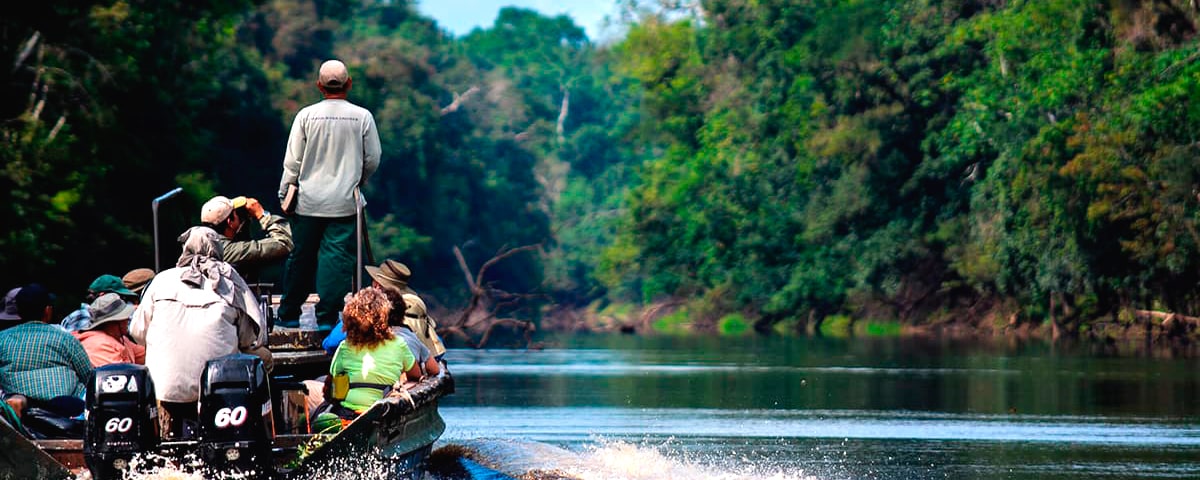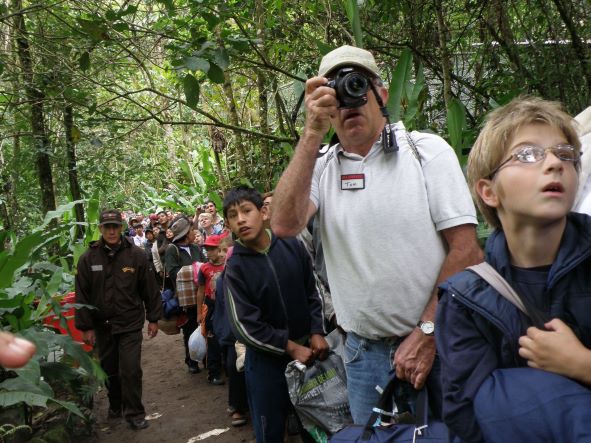It represents more than 70% of the Peruvian territory and is entirely comprised in the Amazon basin.
The proximity to the Andes and the scarce human presence make its forests the most biodiverse on the planet.
The Amazon Rainforest is considered the World Capital of Biodiversity, Its pristine state and the measures adopted for its conservation ensure a good experience for visitors. This region still houses groups of nomadic natives who have no contact with our world, contact with the “civilized” world.
Location of Amazon Rainforest

Wild Amazon Expedition 
Selva Amazónica peruana
The Amazon Rainforest is the largest jungle on the planet, and extends in part of the territories of Peru, Colombia, Ecuador, Brazil and Venezuela. In Peru, it occupies 782,880 km2 of territorial surface, corresponding to 62% of the country’s territory and 13% of the continent’s total, and the second largest after Brazil.
The Amazon Rainforest begins in the eastern foothills of the Andean Cordillera, and extends to the Peruvian political borders with Brazil, Colombia and Ecuador, in the territory of the Peruvian departments of Loreto, Amazonas, San Martín, Ucayali and Madre de Dios. All this, of course, in the center-west of the South American subcontinent.
The location of Amazon Rainforest is divided into mountain jungle or high jungle (in the mountain range) and tropical forest or low jungle (in the plains and the foothills).
Physiography
The Amazon Rainforest physiography presents two clearly differentiated zones: the low jungle or Amazon plain, and the high jungle that rises towards the Andean heights.
The low jungle has as its main characteristic the presence of large rivers, mighty and large forests, with trees that can exceed 40 meters in height, while the high jungle is crossed by rivers of clear and torrential water, valleys and deep ravines. of profuse vegetation that goes from the cloud forests in the highest part (3000 masl) to the high forests of the plain (280 masl.), the high jungle is more rainy than the low jungle.
Amazon Rainforest Facts
Here we mention some interesting Amazon Rainforest Facts that you should know:
- More than half of Peru is covered by jungle and rainforests. In particular, the Amazon Rainforest is the most famous in the world.
- Amazon Rainforest contains thousands of indigenous plants and animals. Some plants are yet to be discovered, and some are even used in modern drugs to cure diseases.
- The Amazon River Basin is the largest rainforest in the world. This rainforest is located in the northeast section of Peru.
- More than 20% of Earth’s oxygen is produced in this area, thus the name “Lungs of the Planet.”
- With 2,5 million square miles, the Amazon rainforest represents 54% of the total rainforests left on the planet.
- Amazon rainforest birds account for at least one third of the world’s bird species, with the toucan being the most popular icon.
- More than half of the world’s estimated ten million species of plants, animals and insects live in the tropical forest.
- About 70% of plants found to have anticancer properties are found only in the rainforest.
- The number of edible fruits found in the rainforest is estimated in 3,000. Amazon natives consume more than 1,500, but only 200 are cultivated for use today.
- An estimated 90% of Amazon rainforest plants used by Amazon natives have not been studied by modern science.
- Today, the number is believed to be of around 250,000 Amazon natives, comprising 215 ethnic groups with 170 different languages. There may also be fifty or so Amazon tribes living in the depths of the Amazon rainforest that have never had contact with the outside world.
Climate in Amazon Rainforest
The climate in Amazon Rainforest marks two basic seasons, the dry season with low water levels and is called summer (April – October) and the rainy season (November – March) in which the water levels rise significantly and generate large areas of land.
Animals in Amazon Rainforest
Wildlife is abundant, the presence of different species is dispersed depending on different habitats and different ecological levels. A good number of animals in Amazon Rainforest have a wide distribution regardless of the altitude ranges. Thus, for example, the Andean Puma can reach Brazil. Studies show that the strip with the highest concentration of biodiversity is between 500 and 1500 meters above sea level.
The Amazon Forest is extraordinarily rich in all forms of animal life, from insects to mammals. One cubic meter of land has 100 times more insects than in the Northern Hemisphere.
Thanks to the large volume of water and a temperate climate, rivers are an ideal place where more than 3,000 species of fish live, representing 85% of all species in South America, and 15% of the species in the world. However, only 40% of these species have been studied by scientists, and only about 36 species of these fish are economically exploited.
This region has many records in terms of variety of animals in Amazon Rainforest, such as: it has more than 100 species of monkeys from the New World (where the smallest is not bigger than a pencil and the largest is comparable to a chimpanzee); thousands of species of birds, such as the colorful macaws and toucans; also dozens of exotic animals such as capybaras (the largest rodent in the world), alligators, the fearsome otorongo (jaguar), varieties of turtles and gigantic anacondas or yacumamma (which can measure up to 12 meters long).
The Tambopata Reserve and the Bahuaja-Sonene National Park are one of the few virgin places with the greatest biodiversity in the world. The Tambopata Reserve and National Park have more than 700 species of birds, 1200 species of butterflies, 90 species of mammals, 120 species of reptiles and amphibians, and countless species of insects. More than 400 species of birds have been recorded only in the areas of the Wasai ecological tours and programs. There are places where it is possible to see more than 100 different species in just a few hours.
Flora of the Amazon Rainforest
Like the fauna, the flora of the Peruvian jungle is abundant, vigorous and extremely diverse, to the point that many of the botanical species that inhabit this region are yet to be discovered and classified.
Only in flowering plants (Phanerogams) there are 7,372 different known species in this region (7% of all species in the world) and some 700 species of ferns (10% of the world’s species).
Tourism
The upper Amazon basin is the place that has one of the highest concentrations of biodiversity in the world and has a spectacular record of flora and fauna species.
We can organize tours ranging from one day to several week expeditions to the heart of the Tambopata – Candamo Reserved Zone or Manu National Park, or a mid-afternoon trip to the beautiful Sandoval Lake. We can also make available special expeditions, student accommodation details and workshops.










